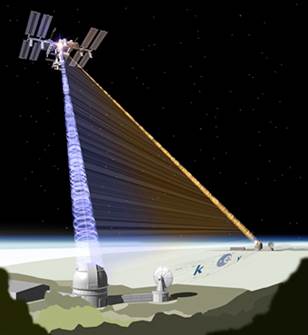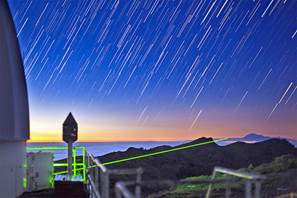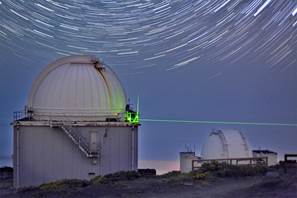Oct 5, 2012
Source:http://www.wired.com/2012/10/quantum-satellite-teleportation
There is an international quantum teleportation space race heating up. Around the world, countries are investing time and millions of dollars into the technology, which uses satellites to beam bits of quantum information down from the sky and and could profoundly change worldwide communication.
This is not a maybe-sort-of-one-day quantum technology. Quantum teleportation has been proven experimentally many times over and researchers are now eyeing the heavens as their next big leap forward. Most of what remains are the nuts and bolts engineering challenges (and some more money) before it becomes a thing of the present.
Though it may be disappointing to hear, quantum teleportation is not about instantly sending a person or object between two places – this is no "Beam me up, Scotty," or "Bampf!" Instead, the technique involves the perhaps even freakier task of separating a subatomic particle from its quantum state.
"Once you disembody the state of one of particle, you can then recreate the particle in remote copy," said physicist and computer scientist Charles Bennett of IBM, who co-authored the first paper on quantum teleportation in 1993.
Though the team’s paper was purely theoretical at the time, scientists since then have done many experiments teleporting particles over longer and longer distances. In the past year, a team from China and another in Austria set new records for quantum teleportation, using a laser to beam photons through the open air over 60 and 89 miles, respectively. This is many times farther than the previous record of 10 miles, set in 2010 by the same Chinese team. With scientists extending quantum teleportation to such distances, many are already considering the next step: zapping particles and information from an orbiting satellite to a relay station on Earth.
If developed, quantum teleportation satellites could allow spies to pass large amounts of information back and forth or create unhackable codes. Should we ever build quantum computers – which would be smaller and exponentially more powerful than modern computers, able to model complex phenomenon, rapidly crunch numbers, and render modern encryption keys useless – they would need quantum teleporters in order to be networked together in a quantum version of the internet.
China plans to launch a satellite with a quantum teleportation experiment payload in 2016 and the European, Japanese, and Canadian space agencies are hoping to fund their own quantum teleportation satellite projects in the coming years. Conspicuously, the U.S. is far behind the pack because of a bureaucratic reshuffling that left quantum communication research experiments without government support in 2008. Whoever loses this new competition could fail to capitalize on the promise of quantum communication altogether.
How It works
The trick to teleportation comes from a quirk of quantum mechanics that allows you to create two particles that are completely in tune with one another, which are known as an entangled pair.
Let’s say you have two entangled photons and you are measuring their polarization, or the direction in which they are oscillating. If one photon has a vertical polarization, you know the other one is going to be exactly the same. The trouble is that quantum mechanics works on probability – before you measure a particle’s polarization it is equally likely to be horizontal or vertical. According to the standard interpretation of quantum mechanics, particles exist in some strange simultaneous vertical/horizontal state until you make a measurement. With an entangled pair, you can just measure one particle, and no matter how far away the other one is from the first, it will instantly gain whatever property you measured.
"It’s like two people play dice and they always get the same result; it’s always random but they always get the same result," said physicist Rupert Ursin of the Austrian Academy of Sciences in Vienna, who works with one team that set the recent distance record.
Of course, even with such dice, there’s no way to compose a signal or transfer information. You could give your friend one die and tell him to stand in another room, agreeing beforehand on a binary system where rolling an even number means 0 and an odd number means 1. But because the outcome of each roll is random, all your friend would end up doing is sending you a haphazard string of zeroes and ones.To send a controllable signal, you need quantum teleportation. This requires three subatomic particles, say photons. Two of the photons are entangled with one another, and the third contains the bit of information you want to send. For a simple example of how this works, let’s say you place one photon from the entangled pair in L.A. and the other in New York.
In L.A., a scientist measures one of the entangled photons and the third particle at the same time. She doesn’t find out their exact properties but just their relative ones – if they are the same or opposite one another – and the particles get destroyed during this measurement. Let’s say she discovers that the particles are opposites and relays this information to her New York colleague. He then measures his entangled photon and knows that the opposite of that measurement is the bit of information he was meant to receive.
Another way to explain it involves a CIA-interrogation analogy that Charles Bennett, co-author of the first quantum teleportation study, likes to use. Imagine that a woman named Alice who lives in Seattle has uncovered information that the CIA desperately needs to thwart an attack. The CIA wants to interrogate her and they need to be able to do it at their headquarters in Washington D.C. Trouble is, Alice doesn’t want to come to D.C. and nothing will persuade her to do so. But the CIA happens to have a pair of magical twin agents named Romulus and Remus who always answer yes or no questions exactly the same way.
So the CIA sends agent Remus to Seattle, not to interrogate Alice, but just to learn if she gets along with Remus. The two meet and get to know each other. Alice discovers that she hates Remus. Every question that she would have answered yes to in life, he answers no. So now all Remus has to do is tell his boss back at headquarters that his and Alice’s answers are opposite. Now the CIA can simply question Romulus to get the information they need.
But just as Romulus and Remus started out together in D.C., quantum teleportation scientists usually don’t have entangled particle pairs just sitting around in two different locations. During an experiment, researchers will often generate an entangled pair in one place. They measure the state of one of the entangled particles and compare that to a third particle containing the bit of data to be sent. They then use a laser beam to send the information about the particles’ relative states, along with the second entangled particle, to another location.
Because subatomic particles are sensitive and small, they’re liable to get lost, meaning that experimenters have to be careful about their protocols. The first quantum teleportation experiments involved sending particles across small spaces, on the order of inches. Eventually, researchers figured out how to shoot a particle several feet, and then hundreds of feet.
"Now we want to show that this kind of communication might be useful on a global scale," said physicist Anton Zeilinger of the University of Vienna, who led the Austrian quantum-distance team. "The method of choice is to use quantum communication via satellite," he added, since photons can’t travel very far in glass fiber without getting absorbed.
The Race to Space
Being able to do this quantum satellite teleportation would provide many new advantages, in particular the ability to create cryptographic keys for sensitive information that would be stored in subatomic particles. If anyone were to measure the particle, they would change its properties so spy agencies would always know if they’ve been hacked. Someday in the future, James Bond and MI6 could be passing secret codes back and forth on a teleported light beam through space.
With this in mind, "there are now a couple of research groups considering how to build a quantum payload suitable for a satellite," said physicist Thomas Jennewein of the University of Waterloo in Ontario, Canada. "There’s basically a race going on to get into space first with a quantum satellite."
Though Japanese researchers are planning a small quantum experiment on a laser-communication satellite named Socrates that will launch in 2014, the only group with a scheduled satellite devoted to quantum communication is from China.
The Chinese satellite would show the feasibility of several technologies, including quantum key distribution, entanglement distribution, and quantum teleportation, said physicist Yu-Ao Chen of the University of Science and Technology of China in Shanghai, who worked with the Chinese team led by Jian-Wei Pan that set the recent distance record. The main obstacle is how to shrink down the large equipment used in their previous record-breaking teleportation experiment, he said.
The Chinese space agency has put $554 million toward funding five scientific satellites over the coming years, one of which will be used for quantum communication. This is a new direction for China, which has in the past launched more than 100 satellites, but until now only one for dedicated scientific experiments. While the exact figure for the quantum communication project is unknown, it could be on the order of $50 to 100 million, estimated Zeilinger. This stands in contrast to Europe and Canada, which have invested an order of magnitude less for their projects.
This has put China in an enviable position. Other teams are lining up for the chance to collaborate and use their satellite for quantum teleportation experiments. "We already have a deal with Austria to use it when it passes over Vienna," said Chen. "Germany, Canada, Italy, and many other groups also want to be involved in this project."
Absent from this tussle is the U.S., whose quantum communication programs have floundered in recent years. Much of this can be traced back to a programmatic reorganization that occurred when the newly created Intelligence Advanced Research Projects Activity (IARPA) – aka DARPA for spies – took over quantum computing research funding from the National Security Agency and National Institute of Standards and Technology in 2008. IARPA said that it would no longer be providing money to the various quantum communications projects because it didn’t want to fund other agencies’ research.
"One of the first things that happened was the quantum communication research program was put into a good deal of chaos, and largely ended," said physicist Richard Hughes of Los Alamos National Laboratory in New Mexico. Many quantum communication researchers were upset, prompting them to write an open letter to John Holdren, director of the White House Office of Science and Technology policy.While in 2012 U.S. government agencies have shown renewed interest in such research, "there’s been a four-year gap and the world doesn’t stand still," said Hughes. "It’s interesting how strong China has become in the last four or five years in the international science scene — they’ve really come along fast."
In order to gain the high ground, all interested countries are racing forward with their technology development. In addition to shrinking the machines used for quantum teleportation to get them aboard satellites, engineers will have to make them usable during all hours. Currently, quantum teleportation experiments only happen at night, because during the day the sun’s light washes out whatever signal researchers are trying to send.
"The greatest challenge in making long-range quantum communication and quantum computing is getting good storage of quantum information," said Bennett. Since photons are readily absorbed in most materials, it’s difficult to keep them around for much longer than a fraction of a second.
In the meantime, everyone is making sure they stay abreast of the latest developments going on around the world.
"We’re not anxious but definitely keeping our eyes open and talking to the various groups," said Jennewein. "We have the sense that we have to keep moving if we want to be part of the early game."
Ursin said that if his Austrian team had the funding, they could develop new experiments in about four or five years. Still, there is a ways to go before people are using quantum teleportation and communication routinely, said Hughes. The technology may feasibly be ready in as little as a decade, but not all new developments are immediately adopted. Cellphones were technically available 40 years ago, but only as unwieldy and relatively powerless devices – it was only in recent times that they became ubiquitous. But others in the field are ready for the next breakthrough.
"For us it’s not a question if these technologies will be used, it’s a matter of when, how, and where will we really use them in everyday life," said Jennewien.
Images: 1) Schematic of quantum teleportation beaming particles from a satellite to two ground stations. 2) and 3) The Austrian team’s laser beam teleports photons between the Canary Islands of Tenerife and La Palma. IQOQI Wien



